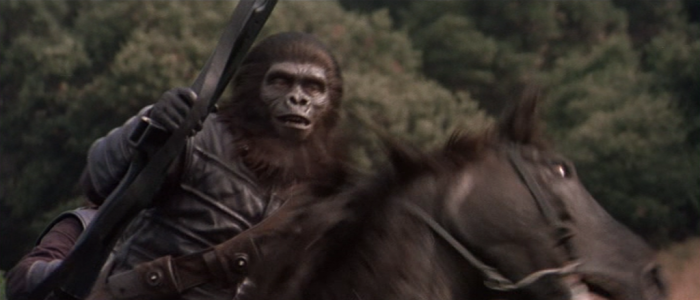
THIS IS AN ARCHIVAL PIECE THAT WAS FIRST POSTED IN OCTOBER 2013.
Directors don’t make films any more – they build worlds. Ever since Marvel hit it big by bringing their multi-character, multi-narrative comic book arcs to the big screen, there’s been a steady trickle of copycats. Man of Steel is the first film of the (albeit stuttering) DC cinematic universe,Amazing Spider-Man seems to have inaugurated a Spidey universe which is likely to introduce the villainous Sinister Six somewhere down the line, while Bryan Singer is returning to the X-Men franchise for 2014′s X-Men: Days of Future Past, which will see the characters from 2011′s X-Men: First Class join forces with those from the Singer/Brett Ratner directed first trilogy (2000-2006). Then, of course, there’s Star Wars, the grandaddy of blockbuster franchises, which is scheduled for a third trilogy along with a seemingly infinite number of spin-off films. Yoda, Han Solo, that dude who had his arm chopped off in the Cantina. No vitally important character will be left unexplored!
Thing is, world-building is hard. Marvel have mastered the art of threading one film’s plot strand into another (the latest being the inclusion of Iron Man 3‘s Extremis arc in the pilot episode ofAgents of SHIELD), and there was undoubtedly a certain geeky thrill to be derived from spotting Wayne Enterprises logos in Man of Steel. But this isn’t world building. Sure, such nods and references convince you that Film A is taking place in the same world as Film B, and yes, if Tony Stark is spotted chatting to Bruce Banner in Iron Man 3‘s post-credit scene it’s clear those characters exist together, but does that actually make the film more real? Does it make the time and place more tangible? To an extent, yes, and I’m certainly not going to pour cold water on anyone who enjoys these little nods. But it takes much more than that to really build a world, and only a handful of films have successfully done so – 2001: A Space Odyssey, Star Wars, andAlien being the most obvious examples.
These films have three elements in common that are overlooked by many when building worlds on film: landscape, culture and music. The need for a tangible landscape is self-evident, but it’s about how that landscape is shot, how the audience is allowed to experience and interact with it, as much as how the landscape actually looks. Culture is the same. Most world-building films give the audience insight into the way the civilisation they’ve built is run, but not enough; this is, incidentally, where I felt Man of Steel fell down, building a distinct Kryptonian culture without ever really exploring it in any real depth. Finally, there’s music, perhaps the most overlooked element for world-building, but perhaps the most important. 2001, Star Wars, and Alien and all used music remarkably well, not simply as an emotional echo for the characters, but as an organic part of the atmosphere. They are the sounds of the world, not just the sound of the film.
There is, however, one film I want to discuss above and beyond the ones already mentioned:Planet of the Apes. Arguably the greatest science fiction movie America has ever produced, and certainly one of the most politically-charged, Franklin J. Schaffner’s masterpiece is also an exemplary example of world-building, using landscape, culture and music to create a world that feels entirely alien, but also entirely believeable. That even after the film’s legendary twist, the audience can still look back on the film and recognise the location as both Earthly and alien at the same time is testament to how well Shaffner, his cinematographer Leon Shamroy, writers Rod Serling and Michael Wilson, and composer Jerry Goldsmith worked together to build the world. Here’s why Planet of the Apes‘ planet is so perfectly crafted…
LANDSCAPE
Planet of the Apes begins with an opening act every bit as astonishing in its sparsity as Paul Thomas Anderson’s more-vaunted There Will Be Blood. After astronauts Taylor, Landon and Dodge have crash-landed on their new mysterious world, they trawl across the landscape looking for food, shelter and some clue as to where in the universe they actually are. Shot on location in Arizona, these scenes made full use of the natural landscape, every frame filled with imposing cliffs, craggy mountains and barren desert. It looks, appropriately considering the finale, like a nuke has hit the place, and as Taylor and crew trudge through it, the landscape get bleaker and the sense of hope more forlorn. It’s a masterpiece of location scouting.
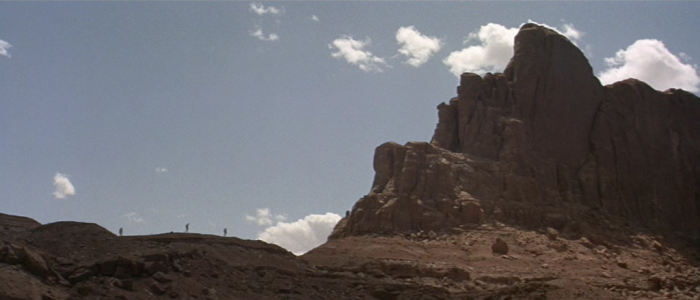
None of this should take away from Schaffner’s incredible direction or Shamroy’s incredible photography. The locations may be stunning, but it’s the unfussy way they’re shot that makes that striking. Schaffner could have added optical effects into the mix, blended a reddish hue into the sky, blackened the ground; it wouldn’t have put too much strain on the budget, it would have been narratively justified considering Earth’s fate, and above all, it would have given this new world a very obvious alien feel, it would have built the world. Schaffner, however, is smarter and more subtle than that, using expansive wide shots to make his actors dots against the vast landscape and context-less sunsets to denote the passing of time. We know that the days are crawling along, but how quickly and with what kind of regularity, we have no idea. We’re as lost as Taylor, Landon and Dodge are.
Criticially, Schaffner also invites us to analyse the screen. The wide shots don’t just give us a sense of alienation, but force us to actively explore the frame, seeking the characters out. Hugh Fowler’s editing is crucial here. Slow and deliberate, it allows us time to explore the world, drinking in every detail as we scour the frame trying to pick Taylor and co out from the desolation. Every time I watch the film, I find these scenes both breathtaking and captivating. They lead to a parade of questions, as I look to the distance and pick out far off mountains and streteches of water. Are there other ape settlements there? Are there other Forbidden Zones? If half the Statue of Liberty is prodtruding out of the ground on one beach, is a bit of the Eiffel Tower somewhere else? Is Big Ben hiding just behind that cliff?
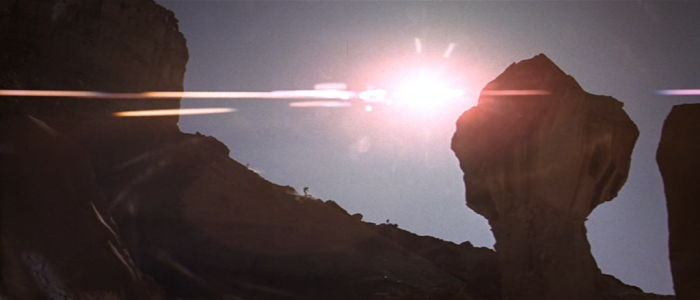
Ultimately, Planet of the Apes‘ world is built entirely in your head, and that’s key here. What Schaffner understood that too-few film-makers grasp with modern-day world-building films, is that the most powerful tool in a director’s arsenal is not a computer, a make-up kit or a matte painting, it’s the audience’s imagination.
CULTURE
It may be a movie about talking monkeys and therefore very easy to dismiss, but Planet of the Apes boasts one of science fiction’s richest screenplays. Between them, writers Rod Serling and Michael Wilson crafted a perfectly realised world that feels entirely tangible, even though we only see one small ape village (you expect there are thousands, if not millions, dotted across the globe). Their work begins even before the apes arrive, with Taylor, Landon and Dodge making reference to doomed female austronaut Stewart, who a line of dialogue suggests, is in a relationship of some kind with Landon. A little later, the three men are discussing their predicament, and Taylor says that their travels prove Hasslein’s Theory. The film never explains who Hasslein is (though we do see him in second sequel Escape from the Planet of the Apes); it’s just a name that lingers, like the landscape, just long enough to spark the audience’s imagination off in several directions at once.
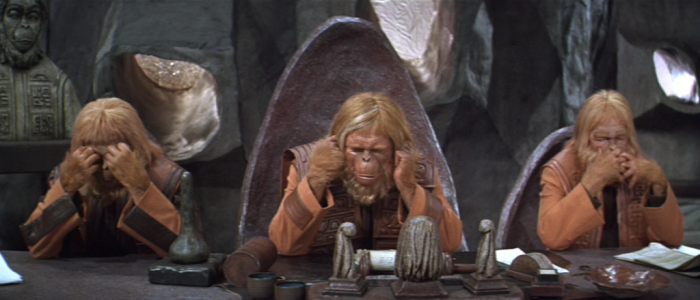
When we get to the ape village, there are further treasures to be found. In one of my favourite scenes, Taylor tries to explain himself to Zira and Cornelius. He tells them he arrived on the planet from another one, flying in on a rocket. Their society having not discovered flight yet, Zira and Cornelius mock the idea, but when Taylor crafts a paper aeroplane to prove his point, they’re stunned into silence. The conversation moves on, of course, and the plane lies prone on the floor before being crushed by Dr. Zaius, but the potential in this scene is fascinating to ponder. Did Cornelius retrieve the crumpled plane from his office? Did he study it to glean valuable learnings? Do the apes use this literally throwaway bit of information to learn flight? Again, the film never returns to it and it’s not mentioned in the sequels (though there is a nice subplot in the brilliant 2011 illustrated novel Conspiracy of the Planet of the Apes), and that’s what makes it so special. Planet of the Apes leaves plotlines dangling so its audience can pick them up.
Finally, and most obviously, Serling and Wilson were two of their time’s most politically astute screenwriters, and they build their political leanings into the apes’ societal structure. This means there’s more than a hint of McCarthyism and the House Un-American Activities Committee to the hearing Zira, Cornelius and Taylor have to endure, and a strict, prejudicial hierarchy in place, with gorillas at the bottom, chimps populating the educated middle classes and orangutangs sitting at the top as the judges. Beyond this, there are further tantilising glimpses at the kind of culture the apes have built for themselves. We hear a doctor chimp called Galen bemoaning the ‘Quota system’ and his inability to climb the ladder at work, we see ape children listening to a lecture on citizenship at school of some kind, and we hear of a Lawgiver whose writings shaped Ape society. Like Hasslein, the sequels would explain him in further depth, thought it wouldn’t be until the final entry, Battle for the Planet of the Apes, that he’s finally seen on screen.
With no easy references or sly nods, Serling and Wilson built a screenplay that treads a fine line between showing and suggesting. It is, Alien aside, perhaps the greatest example of that delicate balance, and endlessly fascinating because of it.
MUSIC
I’ve mentioned Alien a few of times now, and there’s one very good reason why both it andPlanet of the Apes build such convincing worlds: Jerry Goldsmith. Let’s not beat around the bush here: Goldsmith was a genius. I see he and John Williams as the two masters of film music, despite the fact they seem to come at the artform from two very different positions. Williams seems to score the emotional landscape, drawing on the heart of the characters to tell their stories though melody. Goldsmith, on the other hand, seems to score the actual, physical landscape, drawing on the world around the characters to contribute to the film’s atmosphere as much as set design, sound effects and lighting. Both composers overlap of course, Williams crafting atmosphere, Goldsmith echoing emotion, but for me (and, it should be noted, I’m no musicologist) that’s where their core strengths lie.
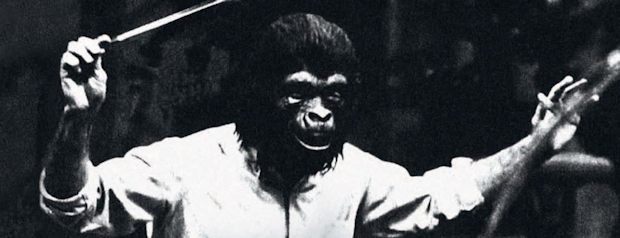
It’s no surprise then that Goldsmith is absolutely integral to Planet of the Apes‘s sense of place. His score for the film is unreal, avant garde and deeply disturbing. As I mentioned, I’m no musicololgist and I couldn’t tell you exactly which instruments Goldsmith used to create the sound you hear during the film, but a part of me doesn’t want to know – it’d spoil the magic and Goldsmith’s unique genius. As he did repeatedly during his career, Goldsmith crafted a soundscape that seems organic and yet entirely alien at the same time. Sure there are strings, drums and wood instruments, but they sound like they’re being conducted by someone entirely and brilliantly unfamiliar with how they’re ‘supposed’ to sound and has decided he’s going to use them however he damn well pleases. There are even some gorilla chants in there too, which Goldsmith uses to particularly wonderful effect in ‘The Hunt’ and which still, to this day, chill me to the bone.
If all that sounds a bit off-putting, it shouldn’t. Planet of the Apes is a very avant-garde score, but it’s also a beautiful one, full of rich strings, full piano sounds and striking melodies. Goldsmith’s genius was his ability to find the perfect balance between the two, and inspire the audience to gaze at their new world in both fear and wonder, two opposing emotions which I think Planet of the Apes captures perfectly. It is, ultimately, just… weird. I can’t think of any other word to better sum it up than that. Planet of the Apes has a weird score that treads the line between mainstream melody and avant garde ambiance so well, it’s neither entirely one nor the other, just occupying a space in the middle that Goldsmith mastered in a way no other film composer truly has. I salute you, Jerry, and your weird monkey noises.
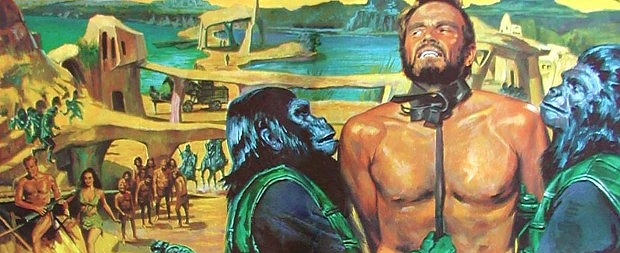
I want to close this piece by jumping forward a few decades – to 2012 and the release of Disney’s horribly under-rated flop John Carter. It’s a very different kind of film to Planet of the Apes, featuring none of its poltical and social commentary, but Andrew Stanton’s film is Apes‘s spiritual successor in the way it builds its world. Crafting a culture and a tangible landscape, and making use of Michael Giacchino’s wonderful score to evoke those things, Stanton’s Mars is an utterly real and compelling one that gets richer and more rewarding with each watch. It is, in my opinion, the finest example of world-building since Star Wars.
Which goes to show how much I know, because its box office failure has rendered a sequel highly unlikely. So perhaps I’m wrong, perhaps Planet of the Apes really isn’t the model for world-building, and perhaps the current approach is spot-in. It’s certainly the one I prefer though. I’ve seen Planet of the Apes countless times since first encountering it when I was 12, and never grow bored, never feel my imagination is entirely sated. It’s the same with 2001, Star Wars, Alien andJohn Carter. That’s the power of world-building. Show an audience a film, and they’re entertained for two hours; show them a new world, and they’re enthralled for life.